Photo above: Israel Chess Composition Society
The International Solving Contest (ISC), traditionally held on the last Sunday of January, has marked the beginning of solving seasons for almost two decades. It’s a hybrid competition, with the same groups of chess problems and endgames distributed around the world to be solved at the same time. This year, it attracted 601 solvers from 28 countries in 38 different locations. Each location had a local controller responsible for the integrity of competition and communication with the Central controller Axel Steinbrink.
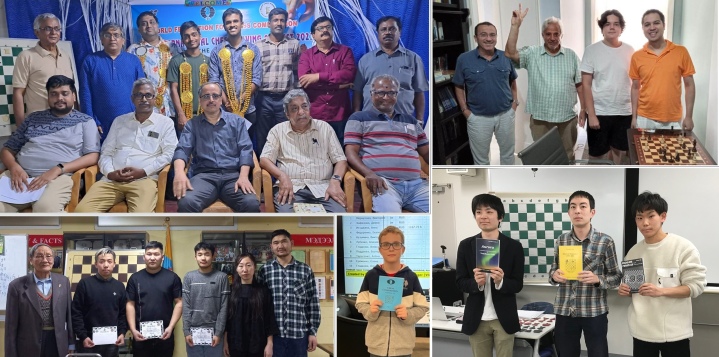 Solvers in Chennai, Rio de Janeiro, Ulaanbaatar and Tokyo | Photo: Mount Chess Academy, Lucas Roland, Tongon Sumiya and Tadashi Wakashima
Solvers in Chennai, Rio de Janeiro, Ulaanbaatar and Tokyo | Photo: Mount Chess Academy, Lucas Roland, Tongon Sumiya and Tadashi Wakashima
The problems, adjusted to three different levels of skills, were carefully prepared by a group of most devoted FIDE Solving Judges: Axel Steinbrink (Germany), Ivan Denkovski (North Macedonia) and Luc Palmans (Belgium). Miodrag Mladenović (Serbia) helped to enter results in the Solving Tournament Manager program (STM), and Borislav Gadjanski (Serbia) took care of the daily live transmission of results on the Mat Plus website. Axel Steinbrink did the most delicate part of the work, checking over a thousand scanned solving sheets. He was on duty for the 14th time!
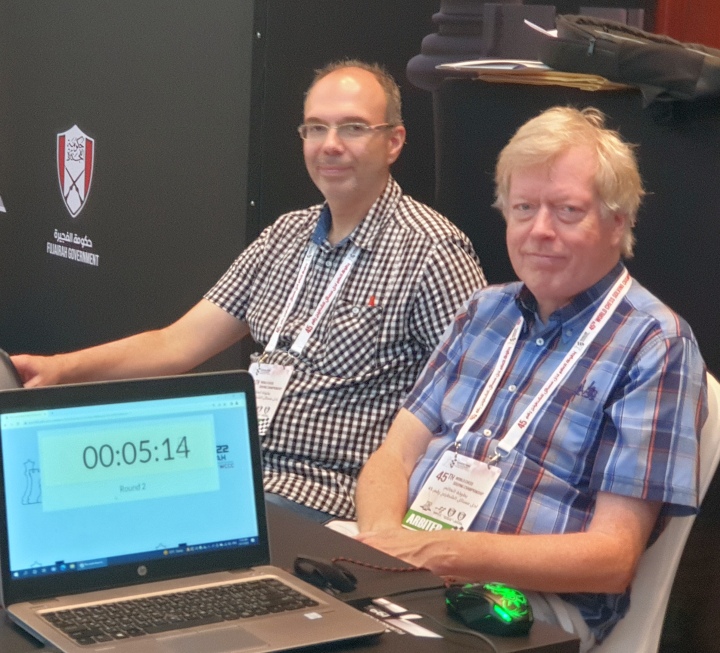 FIDE Solving Judges Ivan Denkovski and Axel Steinbrink | Photo Fujairah Chess & Culture Club
FIDE Solving Judges Ivan Denkovski and Axel Steinbrink | Photo Fujairah Chess & Culture Club
They were the real heroes of the ISC 2023, each of them volunteering for the solvers’ entertainment, the way most of the projects by the World Federation for Chess Composition (WFCC) are done. The ISC is a friendly and easy-to-join competition aimed at popularizing chess art in the first place.
After the careful supervision of the solving sheets, the ISC 2023 Winners were announced. The 1st and the strongest Category had 12 problems split into two rounds of 120 minutes each. Together, there were two problems from each of the six different genres: mate in 2, mate in 3, mate in more moves, endgame, helpmate and selfmate. (This year, because of the sanctions, there were no competitions of the 1st and 2nd Categories in Russia and Belarus).
In spite of the relatively long average time of 20 minutes per problem, it’s usually extremely difficult to get the perfect 60 points result (5 points per problem) in Category 1, and the 2023 edition was no exception. The main hitch was the following endgame:
 White to play and draw
White to play and draw
What looks like an elementary ending hides, in fact, a long sequence of the only moves on both sides before all resources get exhausted. The most successful solvers ended their search before the 9th move and got 3 points out of 5. There were five more moves to find, and only the Indian Grandmaster Karthikeyan Murali got 4 points.

The ISC winner, Ofer Comay of Israel (second from the right on the first photo), also netted 3/5 in this endgame, but overall he scored 58 points and spent a shorter time (215 minutes) than Eddy van Beers from Belgium (2nd place) and Kacper Piorun of Poland (third place).
The win of a senior solver (65+) may sound like a huge surprise, but the skills of the triple World champion in solving should never be underestimated. Ofer won WCSC in his first appearance back in 1980 and did it again in 1985 and 1996.
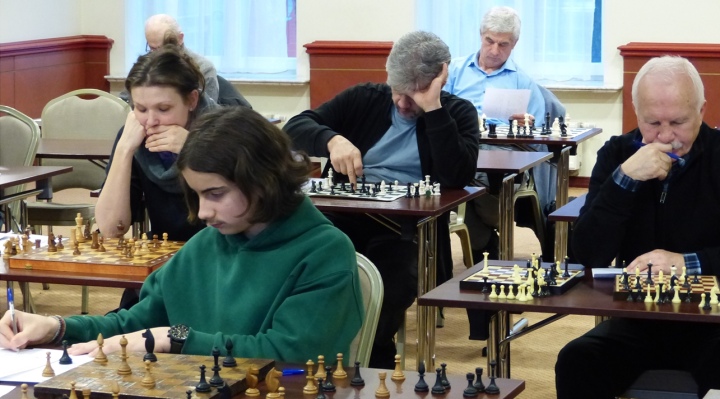 Solvers in Lativa | Photo: Latvijas Problēmšaha Biedrība
Solvers in Lativa | Photo: Latvijas Problēmšaha Biedrība
The best lady was Woman Grandmaster Laura Rogule (pictured above), 12 times chess champion of Latvia, and Ilija Serafimović (18) from Serbia was the most successful among the youngest participants (U23).
The ISC Category 2 was for the participants with solvers rating up to 2000. It had the same format and genres as Category 1, but the problems were less difficult. The top result by the 15-year-old Daniel Dumitrescu and the 3rd place-finish by Radu-Cristian Fluerariu (20) confirmed the rise of the Romanian solvers, while the 2nd place was another success of the Latvian talent Emils Tabors (16).
Among the obstacles to overcome, the next mate-in-five raises a tricky question: how to activate Rook and King – to the left or to the right side? The answer turned out to be – to both sides.
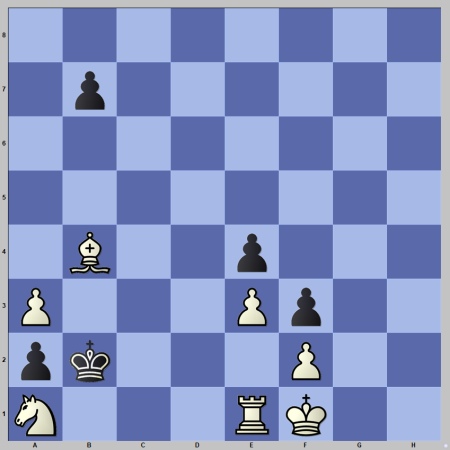 White to play and mate in five moves
White to play and mate in five moves
The ISC Category 3 was a youth U13 competition (for those born in 2010 and later). It lasted 120 minutes and included 6 problems: 4 of them in 2 moves, 1 in 3 moves, and 1 endgame. This time youngsters had no trouble reaching the maximum of 30 points.
No less than six of them did it, and the three winners were extremely fast. Grigory Filin spent only 22 minutes, Taras Rudenko – 26, and Viktoriya Merkulova – 28 minutes!
To get the feeling of the traps the kids had to avoid, you may try to crack the following three-mover. Out of several seemingly equal choices, only one leads to the goal!
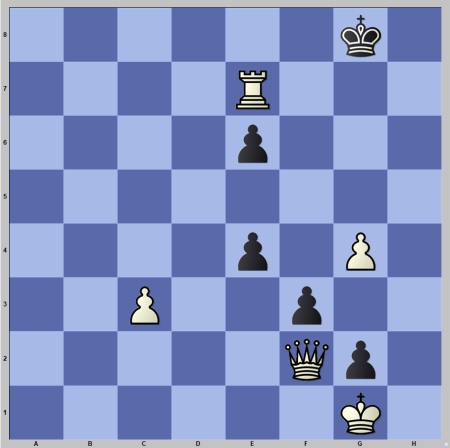 White to play and mate in three moves
White to play and mate in three moves
The season of international solving competitions continues with the open championships of Finland (February 18), the Netherlands (March 4), and Poland (March 4-5). All of them are legs of the World Solving Cup, organized by the World Federation for Chess Composition.
The solutions to the problems from ISC 2023 (with points in brackets)
1. (Martin Minski, Original for Seven Chess Notes 2023) 1. f4! Kxf4 2.Nf2 [1] 2. … K 3 3.Ng4+ Ke2 4.Ne5 [1] 4. … Bd7+! 5.Kc7! Bg4! 6.Bf1+! [1] 6. … Kf2! 7.Nd3+! Ke3! 8.Nb2 Kd4 9.Bb5! [1] 9. … Kc3 10.Bd7 Be2 11.Na4+ Kb4 12.Nb2 Kb3 13.Nd3! [1] (13. … d1Q 14.Ba4+! Kxa4 15.Nb2+)
2. (Isai Hillel Rozenfels, Shakhmaty v SSSR 1954) 1.a4! b5 2.Kg1 bxa4 3.Rf1 a3 4.Be1 & 5.Bc3# [2.5] 1…b6 2.Rd1 b5 3.Ke1 bxa4 4.Kd2 a3 5.Bc3# [2.5]
3. (Vladimir Bron, 1. Pr. Ukraine T. 1952) 1.Rd7! e5 2.Qa2+ & 3.Qa8# 1…Kf8 2.Qc5+ & 3.Qc8# 1…e3 2.Qxf3 & 3.Qa8# 1…Kh8 2.Qh4+ Kg8 3.Qd8#
Text: Marjan Kovačević, WFCC President
Official website: https://www.wfcc.ch/

